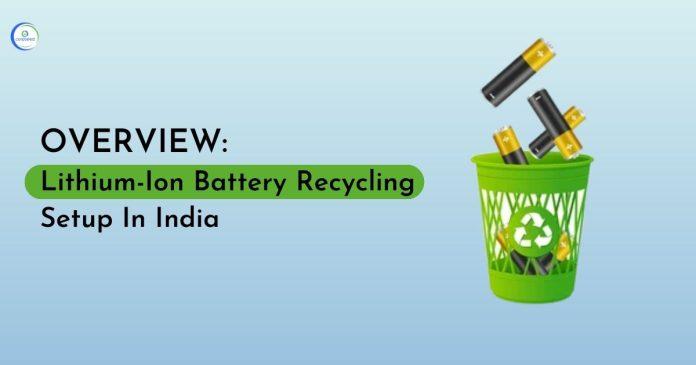Introduction: Lithium-Ion Battery Recycling
Lithium-ion batteries have become an integral part of our lives, powering everything from our smartphones and laptops to electric vehicles and renewable energy storage systems. As the demand for these batteries continues to grow, so does the need for proper recycling methods.
Lithium-ion battery recycling is an essential process that allows us to recover valuable materials, reduce environmental impact, and promote sustainability. Lithium-ion battery recycling not only helps conserve valuable resources but also prevents potential environmental hazards. By recycling batteries, we can minimize these risks and ensure that the materials are handled and treated in an environmentally responsible manner. Establishing a lithium-ion battery recycling plant can contribute to resource conservation, waste reduction, and the recovery of valuable materials.
Different types of Batteries
Batteries are essential energy storage devices that power a wide range of devices and applications in our modern world.
- Lithium-ion Batteries: Li-ion batteries provide high energy density, allowing for longer runtimes and faster charging compared to other battery types. They are rechargeable and commonly used in smartphones, laptops, electric vehicles, and many portable electronic devices.
- Nickel-Metal Hydride Batteries: Nickel-Metal Hydride batteries provide good capacity, are more environmentally friendly. NiMH batteries are rechargeable and offer an improvement over older nickel-cadmium (NiCd) batteries. They are commonly used in digital cameras, cordless phones, and handheld gaming devices.
- Lead-Acid Batteries: Lead-acid batteries are commonly used in automotive applications, uninterruptible power supplies (UPS), and forklifts. Lead-acid batteries are known for their robustness, high surge currents, and ability to deliver steady power over a long duration.
- Lithium Polymer Batteries: Lithium polymer (LiPo) batteries are widely used in drones, remote-controlled vehicles, and portable consumer electronics. LiPo batteries are lightweight, flexible in shape, and have high energy density.
Benefits of Lithium-Ion Battery Recycling Business
- Conservation of valuable resources
- Reduction of environmental impact
- Recovery of valuable materials such as lithium, cobalt, nickel, and manganese
- Minimization of hazardous waste and associated risks
- Promotion of sustainability
- Decreased reliance on mining for raw materials
- Reduction of carbon footprint in battery production
- Collaboration with governments, manufacturers, and organizations for comprehensive recycling infrastructure
- Contribution to a cleaner and greener future.
Recycling Methods of Lithium-Ion Battery
- Mechanical/Physical Separation: The method involves either shredding or crushing the batteries so they can be broken down into smaller components. After shredding, different techniques including sieving, magnetic separation, and eddy current separation are used to separate different battery components like electrodes, electrolytes, and casings. Mechanical separation facilitates the recovery of valuable metals and plastics.
- Pyrometallurgical Process: This process involves the battery being subjected to high-temperature treatment typically in a controlled furnace. In order to prevent environmental pollution, the high temperature causes the batteries to break down and the resulting gases are collected and treated. The remaining material, known as the “black mass,” is further processed to extract metals like lithium, cobalt, nickel, and copper.
- Hydrometallurgical Process: The method consists in dissolving and breaking down different components of a battery using chemical solutions. The batteries are first crushed and then mixed with appropriate solvents or acids to extract the valuable metals. To recover metals like lithium, cobalt, nickel, and manganese, different methods such as leaching, precipitation, and solvent extraction are employed.
- Electrochemical Process: This innovative method of battery recycling uses electrochemical techniques to remove metals from lithium-ion batteries. The batteries are immersed in an electrolyte solution, and a direct current is applied. This process allows the selective deposition of metals to electrodes, which is helpful in their recovery. Electrochemical processes offer high metal recovery rates and can be more environmentally friendly compared to other methods.
- Direct Reuse: In certain cases, lithium-ion batteries can be refurbished and directly reused without going through a recycling process. This involves testing the batteries, replacing faulty cells, and ensuring their safe and efficient operation. Direct reuse extends the lifespan of batteries, reduces waste, and delays the need for recycling.
Machines used for battery recycling
- Battery Shredder: Shredders are battery machines designed to shred lithium-ion batteries into smaller pieces. These machines are equipped with sharp spinning blades to shred the batteries, facilitating subsequent separation processes.
- Crushing Machine: Crushing machines are used to further reduce the size of the shredded battery components. They use mechanical force to pull the batteries in finer particles, which makes it easier for them to break down various materials.
- Sieving Equipment: It is used to separate the shredded battery materials based on particle size. This helps in segregating different components like electrodes, electrolytes, and casings for further processing.
- Leaching Reactors: Leaching reactors are used in hydrometallurgical procedures to separate and extract valuable metals from battery components. These reactors facilitate the chemical reactions involved in leaching processes, where acids or solvents are used to dissolve metals like lithium, cobalt, nickel, and manganese.
- Smelting Furnaces: Smelting furnaces are used in pyrometallurgical processes to melt shredded battery materials at high temperatures. This process facilitates the separation of metals from other components. Smelting furnaces enable the recovery of metals like lithium, cobalt, and nickel in their molten form.
